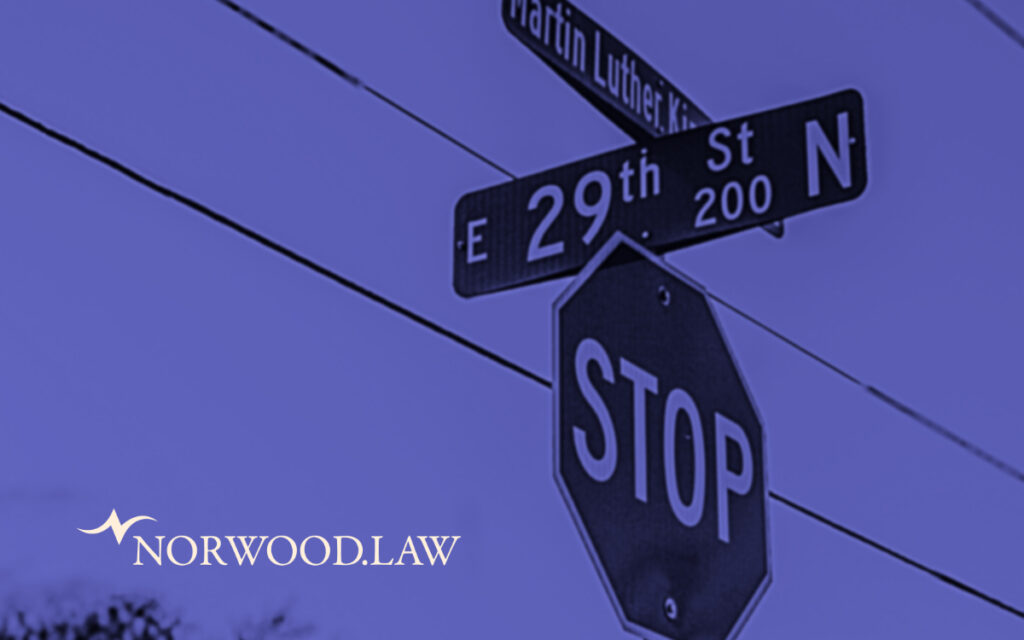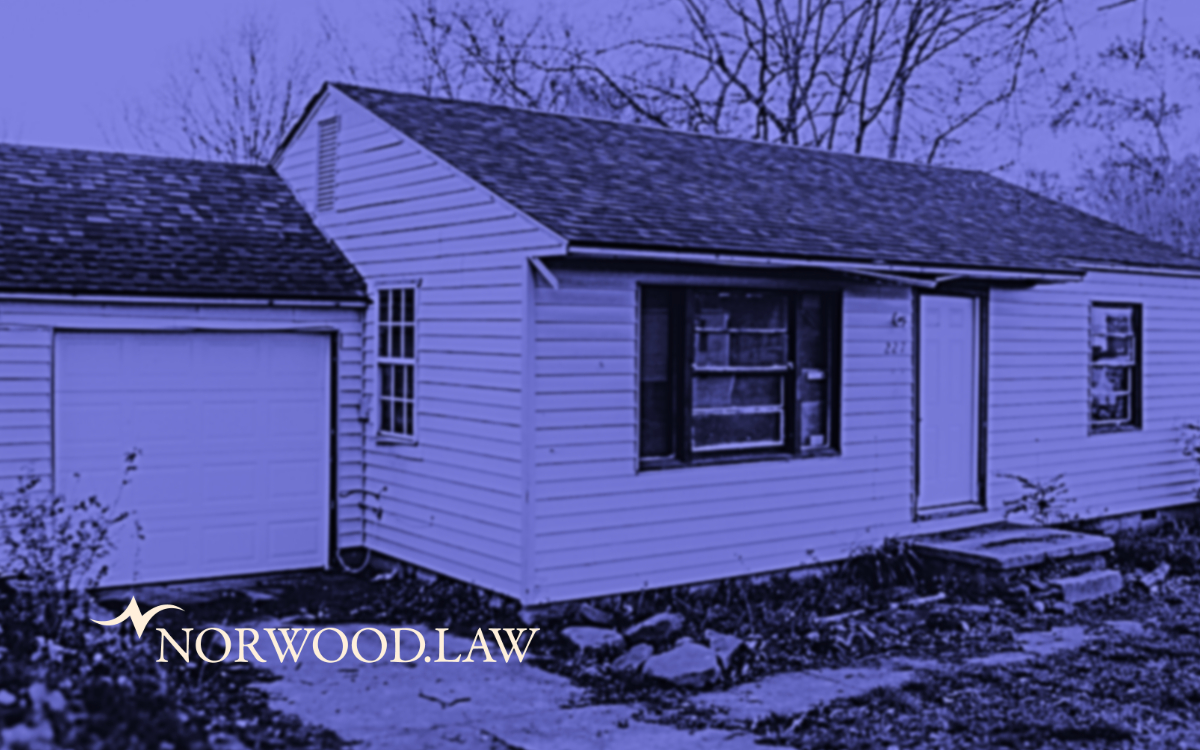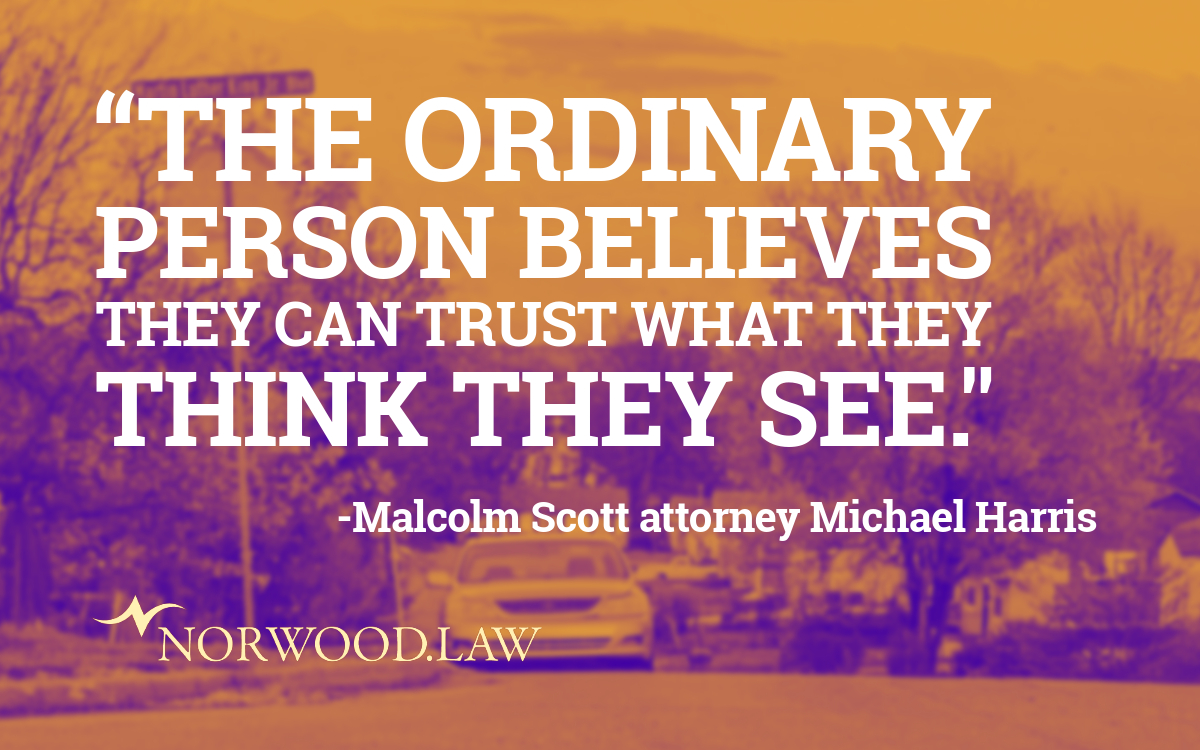Site of a 1994 driveby shooting in Tulsa that led to two wrongful convictions. Image by G.W. Schulz
By G.W. Schulz
Two eyewitnesses and night-time visibility.
That was all Tulsa County prosecutors needed in 1995 to send Malcolm Scott and Demarchoe Carpenter to Oklahoma’s prison system for murder.
And there’s more. Malcolm Scott’s brother, Norwood.Law client Corey Atchison, was already in prison at the time for a wrongful conviction of his own.
In the case of Malcolm Scott and Demarchoe Carpenter, they were both 17 at the time of their arrests and hadn’t yet finished high school.
They experienced the awkward transition from boyhood to manhood while locked up. It would take 22 grueling years for them to make it back into the sunlight. Carpenter and Scott were finally able to prove their innocence on May 13, 2016.
But getting there meant having to fight for longer and with more evidence than prosecutors had needed to convict them. Their trial had lasted four days.
The deadly driveby shooting that started it all took place at a party north of Tulsa on Sept. 10, 1994. A 19-year-old young woman named Karen Summers was killed and two other partygoers were injured.
All along, the gun and car used in the shooting pointed to another man named Michael Wilson. He was childhood friends with Malcolm Scott before their lives took different paths.
Tulsa police investigators knew all about this other man from the start. But they allowed the real killer, Wilson, to accept a plea agreement in exchange for aiding law enforcement. In return, Wilson faced only a fraction of the harsh prison sentences handed down to Scott and Carpenter.
According to a lawsuit we later filed on behalf of Carpenter and Scott:
“Plaintiffs have filed this lawsuit seeking justice for the unfathomable wrongs inflicted upon them. They hope to find and expose the full truth concerning their mistreatment. It is their sincere wish that not one other innocent person is ever again forced to endure prolonged imprisonment, indignity, pain, and humiliation.”
Keep reading for the full story.
Accused of a crime? Hurt in an accident? Let us fight for you. Caught in a family, business, or personal-injury dispute? Norwood.Law will advocate for you the way we do for America’s wrongfully convicted.
Our work has earned Norwood.Law local, state, and national media coverage. We also handle wills, trusts, and estates. Reach out by visiting Norwood.Law or calling 918-582-6464 for a consultation.
Freedom slips away
Two key witnesses outside the party initially told police they couldn’t see who was in the car that night. It was dark out. The car was moving quickly. Gunfire was bursting.
Then they were more formally interviewed by police investigators.
Suddenly, the two witnesses changed their stories. But they didn’t seem committed to the new claims. One of the witnesses struggled to say affirmatively that Malcolm Scott and Demarchoe Carpenter had been in the car.
Prosecutors had no other major evidence in the case to present. There was no physical evidence at all. During the trial, they painted the picture of a heartless, gangland murder in a world that stopped caring.
That was enough for Demarchoe Carpenter and Malcolm Scott to be convicted and have their liberties taken away. The real killer, meanwhile, quickly went on to commit a gruesome new crime.
One of the police investigators involved with this case was also enmeshed in the other high-profile wrongful conviction of Malcolm Scott’s brother, Corey Atchison.
Bound and beaten
Michael Lee Wilson, the alternate suspect, made a crucial admission in the earliest days after the shooting. He had not loaned his car or gun to anyone else. Both were tied to the murder.
This fact didn’t sway investigators.
Then, while Scott and Carpenter were locked up, Michael Wilson was out on bond in the case and free to commit new crimes.
That’s when he carried out a brutal murder. Wilson and three friends tied up the manager of a QuikTrip in the back of a Tulsa location. The man was then beaten mercilessly with dozens of strikes from a baseball bat until he died.
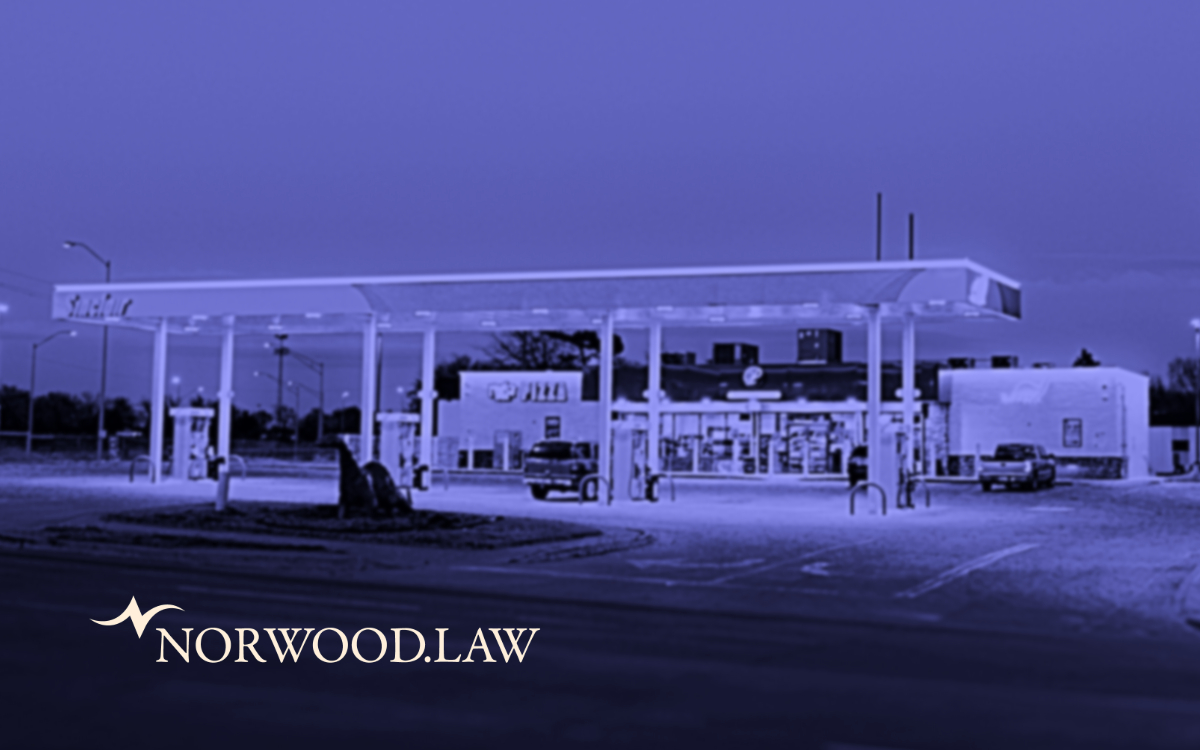
Two of the friends from QuikTrip were also in the car with Wilson the night of the driveby. But they allowed Carpenter and Scott to take the fall while they tortured a convenience-store manager.
According to a later ruling in the QuikTrip case: “[The employee] was found beaten to death in a pool of blood, beer, and milk. Part of a broken set of handcuffs was found near his right hip. The medical examiner found a pin from these handcuffs embedded in [his] skull during the autopsy.”
Memory and the mind
Throughout their ordeal, Carpenter and Scott maintained their innocence.
There wasn’t just a lack of physical evidence.
The darkness that night and the movement of the car were enough on their own to make any attempt at identification remarkably difficult.
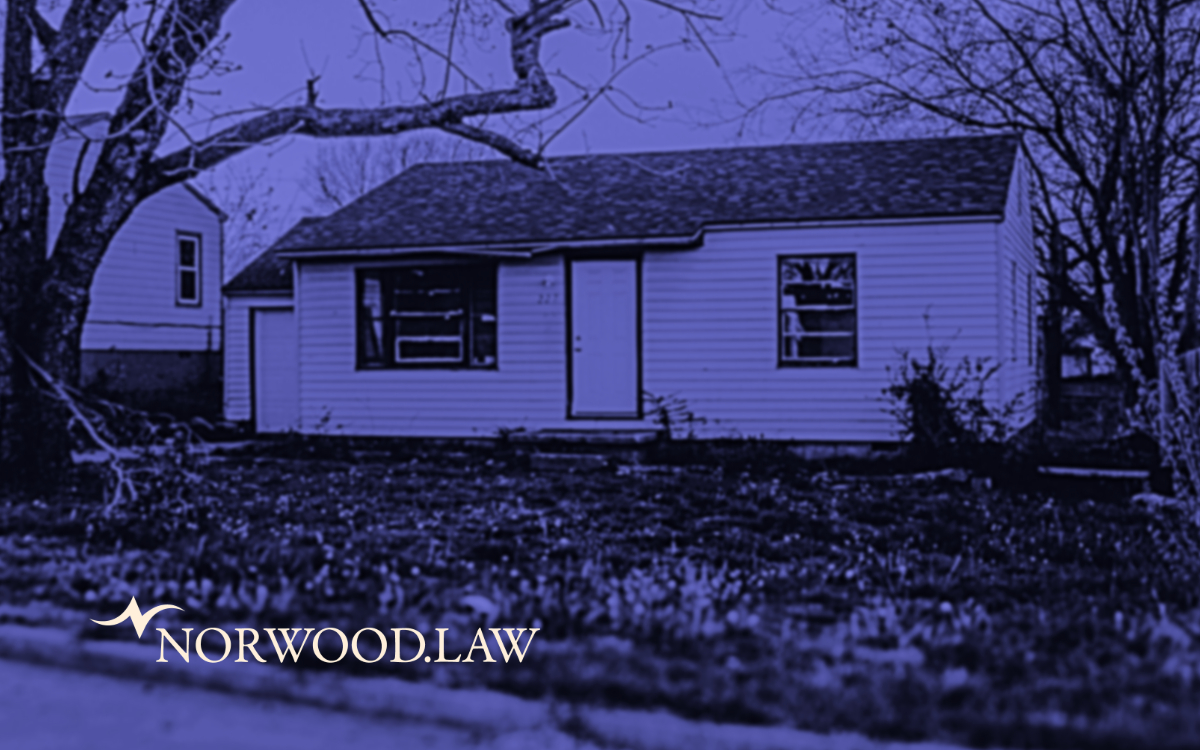
Michael Harris, the then-attorney for Malcolm Scott, said later that plea deals had been offered to the eyewitnesses in the case as enticements.
But America’s courts with time have gradually realized that eyewitnesses are not as reliable as we thought. A swell of studies in recent decades has shown that human beings are alarmingly worse at remembering faces and events than we thought.
Judges and juries and moms and flight attendants and police and teachers don’t enjoy any special immunity from these limitations. An eyewitness can testify with all the sincerity in the world and still be tragically wrong.
“The ordinary person believes they can trust what they think they see,” Defense attorney Harris wrote in an affidavit.
Wrongful convictions are further fueled by cognitive biases that affect the judgments of detectives as well as everyone else on earth. They’re wired into the construction of our minds to help us make decisions quickly.
But these biases can unintentionally cause errors and deviations from our desired goals. One of the best-known biases is “confirmation bias.” As human beings, we tend to gravitate toward evidence that supports an existing hypothesis or viewpoint and pass over evidence that doesn’t.
‘I didn’t see’
After the driveby took place that night in 1994, Tulsa police arrived to investigate. They examined .380 shell casings found in the street and took witness statements.
Later they went to the hospital to interview two would-be witnesses who were at the party. Kenneth Price had been shot and injured among the young revelers. He told police that he did not see who was in the car or who fired the gun. He said his back was turned away. According to a transcript:
Det. Gary Meek: “Ken, you sure you didn’t see who was in that car?”
Price: “I didn’t see who was in the car, for sure.”
After police pressed him, however, his story changed. So did the story of another witness named Rashun Williams following police interviews. Now they claimed to be able to see the car’s occupants through the dark night and could name the suspects.
Price said later: “The police made me believe that I would be charged with the murder if I did not help them by saying Malcolm and Demarchoe were the shooters. After that, I went along with what the police wanted me to say.”
Tulsa police investigators first interviewed witness Rashun Williams at Tulsa Regional Medical Center. Like Price, Williams told police that he could not see the shooter. But then after being interviewed by Det. Meek that night, Williams’s story changed. Now he claimed that Scott and Carpenter “could” have killed Karen Summers.
Citing this evidence and more, Norwood.Law is representing Malcolm Scott and Demarchoe Carpenter in a federal civil lawsuit over their wrongful convictions and over two decades in prison. It names the city of Tulsa and Tulsa law enforcement.
Wouldn’t let go
The most astonishing fact of all is that the real killer was in front of police all along, and he ultimately confessed to the driveby. Even he was perplexed about why police had focused so much of their attention on Scott and Carpenter. The gun and car had both pointed to Michael Wilson as the offender.
Yet investigators from the Tulsa Police Department and prosecutors from the Tulsa County District Attorney’s Office refused to believe Wilson had pulled the trigger. Carpenter and Scott had to endure more than 20 years of confinement before a judge finally saw the truth.
The prosecutor who sent Scott and Carpenter to prison in the first place later admitted the case was deeply problematic. He told the Tulsa World in 2014 that the witnesses kept giving conflicting statements. “I quit interviewing them, because every time I interviewed them, they’d say something different. … It was one of those cases where I was thinking, ‘Good God I hope that case doesn’t come back.’”
Before the truth emerged, however, investigators narrowed their attention to Carpenter and Scott and wouldn’t relent. Tulsa police Det. Gary Meek even inexplicably closed the case before forensic analysts tied the gun that killed Karen Summers to Michael Wilson and not Scott or Carpenter.
The psychology of wrong
Two major contributing factors to wrongful convictions are what psychologists call “confirmation bias” and “tunnel vision.”
As human beings, we have a natural tendency to favor evidence and information that confirms an existing hypothesis or point of view we hold. We conveniently overlook evidence that clashes with those views. Confirmation bias and tunnel vision cause us to tighten our focus so much we squeeze out the full range of possibilities in an inquiry.
These are among innumerable cognitive biases that psychologists have discovered in recent decades that can either help or hurt us in a given moment. Not all areas of our minds are programmed to always know what we want or how we feel about the outcome of an action. The purpose of cognitive biases is to help us simplify information processing and make decisions quickly.
Today it’s possible to better understand why wrongful convictions occur so often. The National Registry of Exonerations contains nearly 3,500 entries. A person is eligible for the registry when there’s “a dismissal of all charges related to the crime for which the person was originally convicted.” The dismissal also must have occurred after new evidence of innocence became available.
It’s safe to say most people in law enforcement who are responsible for these cases don’t set out to take away a person’s liberty. But law enforcers might become more willing to break the rules and violate constitutional rights if they believe doing so is noble. Becoming the police, prosecutor, judge, and jury all at once is justified if the cause is just.
The truth emerges
Trial was held in November 1995. Despite the slim evidence, Scott and Carpenter were convicted of first-degree murder in the killing of Karen Summers. The two people who were in the car with Michael Wilson that night, Billy Alverson and Richard Harjo, were never charged with anything. Both would later admit their roles in affidavits.
But no available police reports show Alverson or Harjo ever being questioned. Alverson said at the time he would have testified at their trial that Scott and Carpenter weren’t involved in the driveby. But he was never called to testify.
At the conclusion of the trial, Scott and Carpenter were each sentenced to life plus 170 years in prison. They attempted for years to challenge the convictions but failed. Their situation became evermore grim.
Then in 2001, the case began to show severe signs of weakness. That’s when Richard Harjo came forward about being in the car that night. Harjo wanted to “right a wrong” by penning an affidavit that supported Scott and Carpenter. Despite this revelation, it would still be several years more before Carpenter and Scott experienced relief.
Finally in 2006, there was a major development. A Tulsa private investigator, Eric Cullen, interviewed all three of the people who were actually in the car that night: Billy Alverson, Richard Harjo, and Michael Wilson. They were all willing to declare that Carpenter and Scott were not involved in the driveby shooting.
Too dark to see
This should mean Scott and Carpenter were finally released, right? No. More years would pass before they were granted an evidentiary hearing in court to make their case.
Billy Alverson signed an affidavit in 2010 swearing Carpenter and Scott weren’t involved.
Kenneth Price, who was shot but survived, also signed an affidavit. He had initially testified against Scott and Carpenter. Now Price said that he was turned away from the car. He was shot in the butt. Not to mention, it was too dark to see anything. Wrote Price in his affidavit:
“I can’t rewind time, so I have to live with what I did. I can’t give Demarchoe Carpenter or Malcolm Scott the years back that they have spent in prison. But I hope freedom won’t elude them any longer.”
His statement was consistent with those of the other testifying witness, Rashun Williams. His own affidavit stated that he was coerced by law enforcers into identifying Carpenter and Scott as the shooters.
Psychologists and law experts have come to understand in recent decades that eyewitness testimony on its own is highly unreliable. From a filing in our case: “The shooting occurred in less than a minute, the shooting occurred at night, and the actual perpetrators were in the backseat of an automobile moving further and further away from the eyewitnesses.”
Three more years passed. Then the true killer himself, Michael Wilson, wrote an affidavit in late 2013. He was the one who shot and killed Karen Summers, Wilson confessed. The following year, he gave a detailed video confession to the Oklahoma Innocence Project, which had become involved with the case by then. Wilson said he was stunned when police didn’t blame him.
“They just let me go. … I had the murder weapon on me, and they let me go.”
A judge would later find that Wilson’s confession was credible and corroborated by available evidence. Wilson again declared Carpenter and Scott innocent just before he was executed on Jan. 9, 2014. He’d been convicted of the unrelated brutal murder at QuikTrip. It was committed while Wilson was out on bond from the driveby case.
Clear and convincing
In early 2014, Scott and Carpenter filed new applications for post-conviction relief. They argued the state failed to disclose exculpatory evidence pointing to the innocence of the two men and knowingly allowed false testimony. A crucial hearing came in early 2016.
Numerous witnesses testified on behalf of Carpenter and Scott. Richard Harjo testified that it was him and Michael Wilson and Billy Alverson in the car that night. He confessed to the court even though he could still be subject to charges in the case.
Then in the spring of 2016, a Tulsa judge, after having reviewed the case, ruled that “clear and convincing evidence” established the innocence of Scott and Carpenter. By that moment, they’d spent over 20 years in prison. From the ruling of Tulsa County District Judge Sharon Holmes:
- She called the case a “fundamental miscarriage of justice”
- The two eyewitnesses had recanted and changed their stories
- Wilson’s belate confession was corroborated by people in the car
- Police found Wilson – not Scott or Carpenter – with the car and gun
- Wilson told police he had not loaned the car or gun to anyone
- No physical evidence ever connected Carpenter or Scott to the crime
The state of Oklahoma attempted to appeal. The Oklahoma Court of Criminal Appeals rejected that appeal on Nov. 10, 2016, in favor of Scott and Carpenter, and upheld the innocence declaration of Judge Holmes in Tulsa. The opinion was biting:
“The state’s case at trial was weak, and the evidence and circumstances that were developed and presented to the trial court did nothing to strengthen the state’s position.”
Blood brothers
Having your freedom stripped away by the government turns out to be a family affair for Malcolm Scott. Scott was released in 2016 after being exonerated. His brother, Corey Atchison, was still separately and shockingly locked up as the result of another wrongful-conviction case.
That seems impossible. But it’s the truth. And in both cases, prosecutors framed the defendants as ruthless gangsters. And in both cases, there was no physical evidence. And in both cases, investigators and prosecutors relied on less-than-reliable witnesses.
And in both cases, Norwood.Law stepped up to fight for the truth.
In the Corey Atchison case, a young man named James Lane was shot and killed on Aug. 3, 1990, in the Kendall-Whittier neighborhood of Tulsa. Investigators pinned the blame on then 19-year-old Atchison.
Just one witness testified at Atchison’s trial. Over two decades later, that witness recanted. Two other witnesses had already recanted statements they made to police blaming Atchison for the crime.
All three witnesses said they had been coerced by police or prosecutors or both. Judge Sharon Holmes agreed they were.
Our lawsuit contends that the police practice of unrecorded threats of arrest and prosecution is “widespread” in the Tulsa Police Department. Such tactics might get convictions, but they get wrongful convictions, too.
Athison ultimately spent 28 years in prison before Judge Holmes declared him innocent like his brother. Holmes said in court on the day Atchison was released:
“This court thinks the purported eyewitnesses who were used were coerced. Without those witnesses, I don’t think a jury would have found Mr. Atchison guilty of this crime.”
